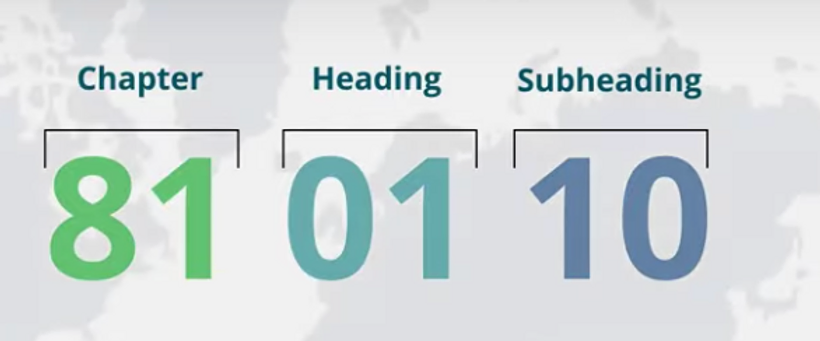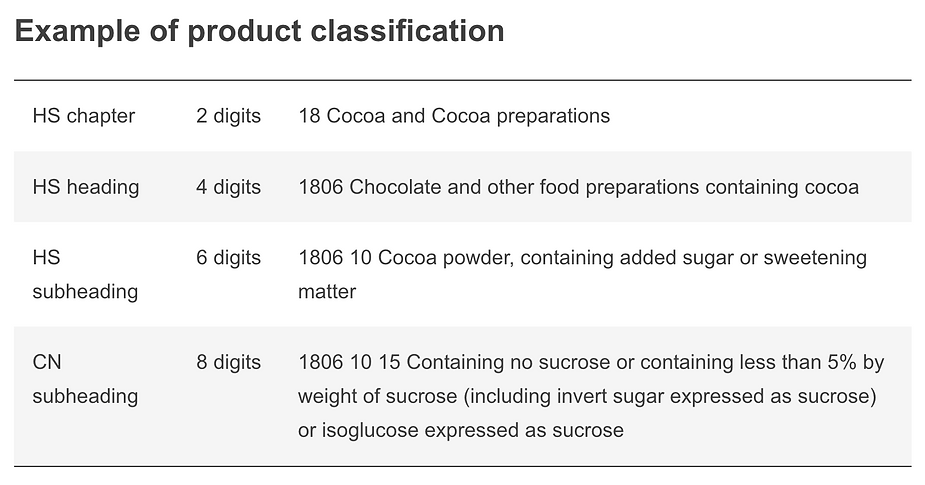The Harmonized Commodity Description and Coding System, generally referred to as “Harmonized System” or simply “HS,” is a multipurpose international product nomenclature developed by the World Customs Organization (WCO).
It comprises over 5,000 commodity groups, each identified by a six-digit code, arranged in a legal and logical structure, and supported by well-defined rules to achieve uniform classification.
More than 200 countries and economies use the system as a basis for their Customs tariffs and for collecting international trade statistics. Over 98 % of the merchandise in international trade is classified in the HS.
Yet since the early 1970s, a group of highly skilled international experts at the World Customs Organization in Brussels created and continues developing a goods nomenclature system that enables nations to monitor goods passing across their borders for these purposes. Without it, many national regulations and international conventions would be unable to be enforced, and considerable guesswork would surround bilateral and multi-lateral trade negotiations. Since its creation in the 70s, the HS code has become a universal economic language essential to the fluidity of international trade.
All international tariffs are now based on this Harmonized System.
The European CN, the US HTS, and all other national or regional tariffs have a common denominator: the Harmonized System, which constitutes the basis for the six first digits. Getting the source of all these national and regional tariffs right gives you a leading edge in classifying your goods correctly.
The HS contributes to the harmonization of Customs and trade procedures and the non-documentary trade data interchange in connection with such procedures, thus reducing the costs related to international trade.
It is also extensively used by governments, international organizations, and the private sector for many other purposes, such as internal taxes, trade policies, monitoring of controlled goods, rules of origin, freight tariffs, transport statistics, price monitoring, quota controls, compilation of national accounts, and economic research and analysis. The HS is thus a universal economic language and code for goods and an indispensable tool for international trade.
It may be hard to imagine what effect a small six-digit code could have on international efforts to reduce global warming, in suppressing the activities of a criminal syndicate involved in the manufacture of synthetic drugs, or on the capacity of a developing country to provide basic health care for its people.
As international trade became more complex and governments around the world demanded greater effectiveness from their Customs Administrations, nations turned toward the WCO’s Harmonized Commodity Description and Coding System (Harmonized System or HS) to be a central pillar of their requirement for fiscal and regulatory compliance. The HS has neared universal coverage, providing history’s most robust globally unifying trade classification tool.
The sophistication of international trade and the increasing concern at cross-border crime has seen the Harmonized System evolve into a multi-purpose tool – a veritable Swiss Army knife – that provides much more than ensuring that what are “apples” in one country are not “oranges” in another.
To a customs official at a frontier post checking a road transport consignment, it provides vital information to assist them in carrying out their duties. Without the essential HS code, there would be confusion, lengthy searches, and delays. It has become a vital partner to other officials coping with waves of sea cargo, airfreight consignments, or express mail. We can expect that this dependence will increase as 21st-century commercial and social demands evolve.

How it works
The Harmonized System is governed by “The International Convention on the Harmonized Commodity Description and Coding System”. The official interpretation of the HS is given in the Explanatory Notes (5 volumes in English and French) published by the WCO, which is also available online.
The maintenance of the HS is a WCO priority. This activity includes measures to secure uniform interpretation of the HS and its periodic updating in light of technological developments and trade pattern changes. The WCO manages this process through the Harmonized System Committee (representing the Contracting Parties to the HS Convention), which examines policy matters, decides on classification questions, settles disputes, and prepares amendments to the Explanatory Notes. The HS Committee also prepares amendments updating the HS every 5 – 6 years.
Decisions concerning the interpretation and application of the Harmonized System, such as classification decisions and amendments to the Explanatory Notes or the Compendium of Classification Opinions, become effective two months after the approval by the HS Committee.
At the international level, the Harmonized System is based on a hierarchy of Sections, Chapters, headings, and subheadings. This has given the WCO the framework to respond to the concerns of many governments and international organizations who want to take steps to counter newly emerging problems. The creation of HS codes for ozone-depleting substances, precursor chemicals to manufacture illicit drugs, hazardous wastes, endangered species, chemical weapons, and narcotics and psychotropic substances are examples of this responsiveness to international concerns. Multiple international conventions, agreements, and initiatives rely on the HS for practical implementation at the borders.
The WCO updates the Harmonized System through a five-year review cycle. The latest version of the Harmonized System was approved in June 2019 and entered into force on 1 January 2022. In addition to input from the Members, the Harmonized System Committee and the Harmonized System Review Sub-Committee also receive input from partnerships maintained by the WCO with diverse international organizations, such as the Food and Agricultural Organization of the United Nations, and from international industry bodies. This regular renewal allows the HS to change as new issues are raised, requiring clear and appropriate responses.
The next update is foreseen for 2028.

It is the foundation for the import and export classification systems used in the United States and by many trading partners.
The HS assigns specific six-digit codes for varying classifications and commodities. Countries are, however, allowed to add more extended codes to the first six digits for further classification.
The United States uses a 10-digit code to classify products for export, known as a Schedule B number, with the first six digits being the HS number. Every physical product, from paper clips to airplanes, has a Schedule B number. The Schedule B is administered by the U.S. Census Bureau’s Foreign Trade Division.
The European Union has its own Combined Nomenclature (CN). This eight-digit coding system comprises the Harmonised System (HS) codes with further EU subdivisions. It serves the EU’s standard customs tariff and provides statistics for trade within the EU and between the EU and the rest of the world.
The CN code, which is the subdivision of the nomenclature, has an 8-digit code number followed by a description and a duty rate. Depending on the case, it may contain a supplementary unit.
CN subheadings, which are stated in declarations for imports and exports, determine which rate of customs duty applies to a particular good and how the goods are treated in statistics and regulations.




